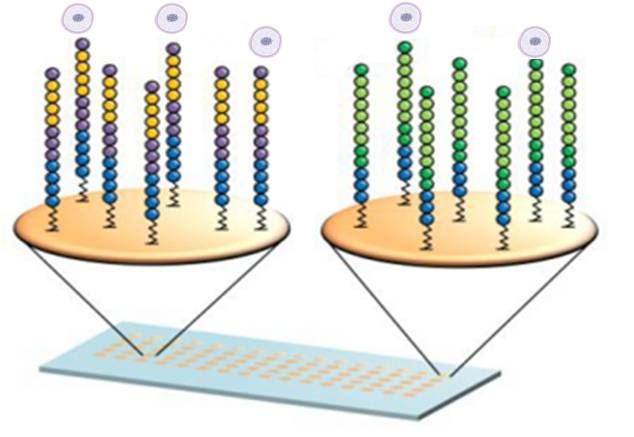Peptide array represents a powerful research tool, especially for the development of medical applications to screen peptides for the replacement of animal-derived proteins. Creative Biolabs has developed an advanced Peparray™ high throughput screening (HTS) peptide array platform. Based on this platform, our scientists apply a new strategy for peptide-whole cell interaction analysis. We are proud to provide this top-quality service to facilitate our customers’ research and project development.
The use of peptides as an ideal synthetic biological material is of great interest in medical and cellular biology. There are increasing applications of peptides, including as a stimulating factor for cellular events, as a scaffold for cell culture and as a tag molecule for specific targeting. In eukaryotes, most anchorage-dependent cells are known to recognize and functionally react with adhesive extracellular matrices (ECMs). In regenerative medicine and tissue engineering, regulation of growth, activation, and differentiation of anchorage-dependent cells is an essential technique to prepare cells for treatment. Massive efforts have been paid out to screen most of these kinds of effective peptides, but they don't work very well. In tumor cells, death receptors that are highly expressed are promising as anticancer molecular targets. As an inhibitor, death receptors regulate cellular homeostasis by inducing apoptotic cell death through stimulation from death-inducing ligands. Recently, Attention has been paid more on tumor-inhibition peptides. Since those synthesized peptides are highly desired as a perfect alternative to animal-derived proteins for clinical applications in the advancing regenerative medicine.
 Fig.1 Solid material-based peptide microarray (Weber et al. 2017).
Fig.1 Solid material-based peptide microarray (Weber et al. 2017).
Through our advanced Peparray™ HTS peptide array platform, Creative Biolabs has adopted an effective strategy for peptide-whole cell interaction analysis. Our scientists employ solid-bound peptides and anchorage-dependent cells method for interaction assay. The cells are directly seeded onto the peptide array spot. The cells are observed by fluorescent image scanner for HTS analysis and scanning electron microscope (SEM) for detailed analysis. Moreover, the screening process is enhanced by bioinformatics analysis method.
This strategy is applied to various types of cells for assaying:
Key advantages of this service including but not limited to:
With years of research and development experience in peptide array, Creative Biolabs has owned a group of scientists who have accumulated extensive experiences. Through our peptide-whole cell interaction analysis service, our seasoned scientists are pleased to share expertise with our clients all over the world.
For more detailed information, please feel free to contact us or directly send us an inquiry.
References
All listed services and products are For Research Use Only. Do Not use in any diagnostic or therapeutic applications.